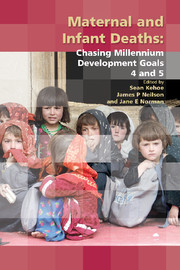Book contents
- Frontmatter
- Contents
- Participants
- Declaration of personal interests
- Preface
- The Millennium Development Goals
- SECTION 1 THE SIZE OF THE PROBLEM
- SECTION 2 CLINICAL PROBLEMS AND SOLUTIONS – MATERNAL
- 5 Postpartum haemorrhage
- 6 Reducing deaths from hypertensive disorders of pregnancy
- 7 Obstructed labour (including partograms)
- 8 Puerperal sepsis in low- and middle-income settings: past, present and future
- 9 Unsafe abortion and strategies to reduce its impact on women's lives
- 10 HIV and tuberculosis
- 11 A pragmatic approach to safe anaesthesia
- SECTION 3 CLINICAL PROBLEMS AND SOLUTIONS – NEONATAL
- SECTION 4 TRAINING AND DEVELOPMENT
- SECTION 5 SPECIFIC CHALLENGES IN SPECIFIC COUNTRIES
- SECTION 6 CONSENSUS VIEWS
- Index
9 - Unsafe abortion and strategies to reduce its impact on women's lives
from SECTION 2 - CLINICAL PROBLEMS AND SOLUTIONS – MATERNAL
Published online by Cambridge University Press: 05 February 2014
- Frontmatter
- Contents
- Participants
- Declaration of personal interests
- Preface
- The Millennium Development Goals
- SECTION 1 THE SIZE OF THE PROBLEM
- SECTION 2 CLINICAL PROBLEMS AND SOLUTIONS – MATERNAL
- 5 Postpartum haemorrhage
- 6 Reducing deaths from hypertensive disorders of pregnancy
- 7 Obstructed labour (including partograms)
- 8 Puerperal sepsis in low- and middle-income settings: past, present and future
- 9 Unsafe abortion and strategies to reduce its impact on women's lives
- 10 HIV and tuberculosis
- 11 A pragmatic approach to safe anaesthesia
- SECTION 3 CLINICAL PROBLEMS AND SOLUTIONS – NEONATAL
- SECTION 4 TRAINING AND DEVELOPMENT
- SECTION 5 SPECIFIC CHALLENGES IN SPECIFIC COUNTRIES
- SECTION 6 CONSENSUS VIEWS
- Index
Summary
Introduction
Harrowing stories of women seeking abortion are universal and commonplace. Take, for example, the story of a Nicaraguan girl who, at 8 years old, became pregnant, raped by her neighbour. Without the help of her family, international attention and several months of hard fighting, this young girl could have become another faceless statistic in the pandemic of unsafe abortion. The outrage many feel in reaction to this and other similar stories has been insufficient to end the political struggle over abortion. What is more, that young girl was fortunate, as one woman dies every 8 minutes from an unsafe abortion somewhere in the world, most likely south of the equator. The greatest tragedy is that unsafe abortion is largely, if not entirely, preventable and yet remains one of the most neglected public health challenges.
Millennium Development Goal (MDG) 5, announced in 2001, is an internationally agreed-upon imperative to reduce maternal mortality by 75% from its 1990 level by the year 2015. As a significant proportion of mortality is due to unsafe abortion, this goal probably cannot be met without specific and direct programmatic efforts to reduce the impact of unsafe abortion. Thousands of publications trace efforts to reduce mortality due to other significant contributors, yet few, if any, papers highlight efforts designed specifically and directly to reduce the impact of unsafe abortion. Additionally, many Safe Motherhood Initiatives ignore altogether the problem of unsafe abortion because of the difficult political issues involved.
- Type
- Chapter
- Information
- Maternal and Infant DeathsChasing Millennium Development Goals 4 and 5, pp. 149 - 162Publisher: Cambridge University PressPrint publication year: 2010



